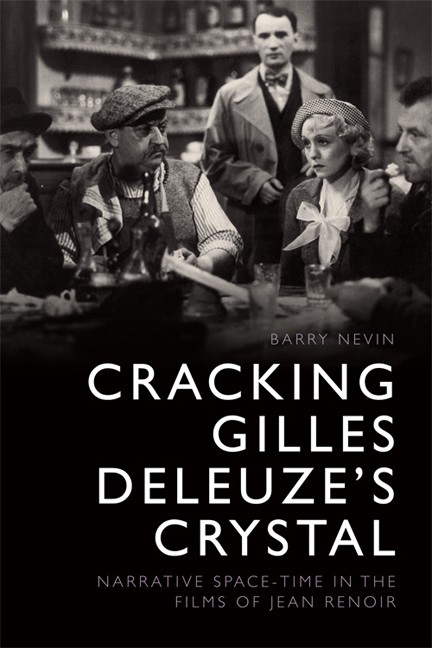Book contents
- Frontmatter
- Contents
- List of Figures
- Notes on Style
- Acknowledgements
- Preface
- Introduction
- 1 Theatrum Mundi: Framing Urban Dynamics in Renoir's Paris
- 2 From Desert to Dreamscape: Viewing Renoir's Rural Landscapes as Spatial Arenas
- 3 Portraying the Future(s) of the Front Populaire
- 4 Renoir's Crises Anti-Réalistes: Framing le Temps Gelé
- Conclusion
- Appendix: Corpus Breakdown
- Notes
- References
- Film Index
- General Subject Index
1 - Theatrum Mundi: Framing Urban Dynamics in Renoir's Paris
Published online by Cambridge University Press: 01 May 2021
- Frontmatter
- Contents
- List of Figures
- Notes on Style
- Acknowledgements
- Preface
- Introduction
- 1 Theatrum Mundi: Framing Urban Dynamics in Renoir's Paris
- 2 From Desert to Dreamscape: Viewing Renoir's Rural Landscapes as Spatial Arenas
- 3 Portraying the Future(s) of the Front Populaire
- 4 Renoir's Crises Anti-Réalistes: Framing le Temps Gelé
- Conclusion
- Appendix: Corpus Breakdown
- Notes
- References
- Film Index
- General Subject Index
Summary
Old Paris is no more (the form of a city Changes more quickly, alas! Than the human heart …
– Baudelaire, ‘Le Cygne’, in Les Fleurs du malIt […] happens that, if you move along Marozia's compact walls, when you least expect it, you see a crack open and a different city appear. Then, an instant later, it has already vanished.
– Italo Calvino, Invisible CitiesIntroduction: Renoir, Cinema, and the City
Building on Deleuze's association of the theatre with the force of the past in Renoir's work, this chapter argues that Renoir's surcroît de théâtralité enters into dialectic with urban dynamics in Paris to produce an image of open space-time in La Chienne (1931), Boudu sauvé des eaux (1932), and La Règle du jeu (1939). To say that Renoir was well acquainted with Paris by 1931 would be an understatement. Renoir himself was born in Montmartre at 13 rue Girardon. The Renoir family divided its time between Montmartre, Essoyes (Aline's homeplace), and Les Collettes in Provence, where Pierre-Auguste spent his final years. Renoir fils nostalgically recounts a number of memorable excursions to various locations in the city in his autobiography, Ma vie et mes films: visits to les Grands Magasins Dufayel where he experienced his first (and ironically forgettable) encounter with the cinema; the Café des Amis where his father frequently met with neighbours; the Guignol at the Tuileries; and plays on the Boulevard du Crime. Furthermore, by the time Renoir was transposing Georges de la Fouchardière's La Chienne to the screen, he had already filmed Nana (1926) in reconstructed belle époque Paris and Sur un air de Charleston (1927) in a post-apocalyptic vision of the city.
Renoir would continue to revisit Paris throughout the remainder of his career: Boudu sauvé des eaux and Le Crime de Monsieur Lange (1936) all take Paris as their primary setting; although La Règle du jeu is better remembered for its photography of la Sologne, the first twenty minutes are set in Paris; French Cancan (1954) and Eléna et les hommes (1956) each celebrated life in the French capital after his Hollywood exile;
- Type
- Chapter
- Information
- Cracking Gilles Deleuze's CrystalNarrative Space-time in the Films of Jean Renoir, pp. 29 - 63Publisher: Edinburgh University PressPrint publication year: 2018



